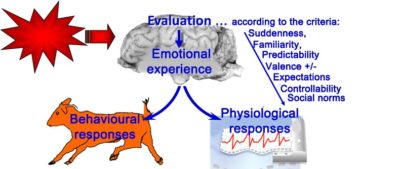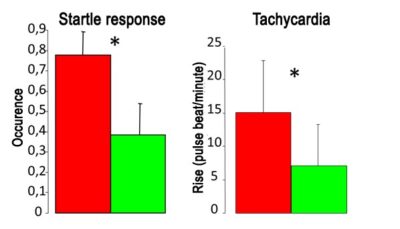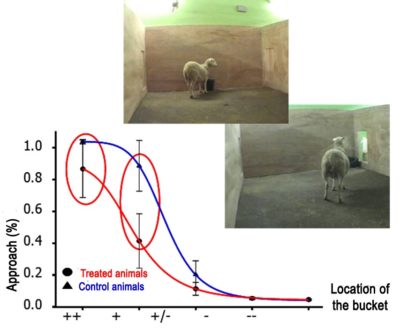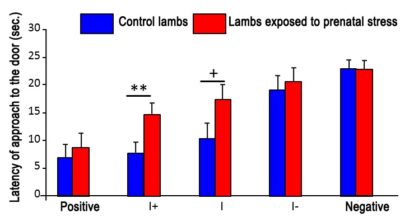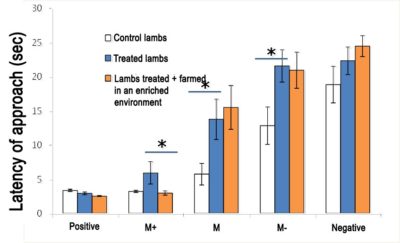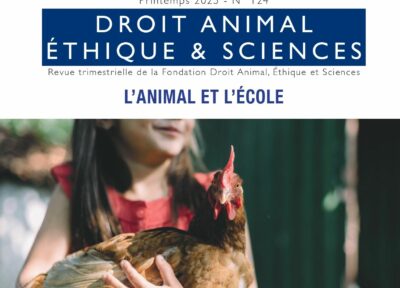by Alain Boissy
INRA, Centre-Auvergne-Rhône-Alpes, France
[DOWNLOAD ARTICLE] [Download complete PDF 6.2Mo]
To cite this article (suggested): Boissy A., « How to access animal sentience? The close relationship between emotions and cognition » [PDF file], In: Hild S. & Schweitzer L. (Eds), Animal Welfare: From Science to Law, 2019, pp.21-31.
Introduction
Animal welfare has become one of the major issues of our modern civilisation due to the evolution of moral questions, the intensive use of animals for testing and production, and the omnipresence of pets. The question of animal sentience is now at the heart of societal concerns. Animals have acquired a legal status as sentient beings in both European law (Treaty of Lisbon, 2007) and French law (« sensibilité de l’animal » enshrined in the French Civil Code via Law No. 2015-177 of 16 February 2015). Animal protection now concerns all animals whose lives are dependent on humans (pets, laboratory animals, farm animals, zoo animals, etc.).
The expression « bien-être animal » was introduced in France in the 1980s from the English word « welfare » which covers both the well-being of an individual (its health, comfort, etc.) and its protection, in other words, the measures defined by legislation to guarantee its welfare. Unlike most concepts developed in biology, there is no unanimously recognised definition of welfare. Nevertheless, most authors agree on the principle that welfare is both a state of physical health, represented by the absence of injury or illness, and of mental health, covering the absence of prolonged negative emotions and the search for positive emotions (Dawkins, 1980; Duncan, 1993). The French Agency for Food, Environmental and Occupational Health & Safety (ANSES) recently proposed an updated definition of animal welfare (2018): the welfare of an animal is its positive mental and physical state linked to the fulfilment of its physiological and behavioural needs in addition to its expectations. This state can vary depending on the animal’s perception of a given situation. Emotions therefore play a key role in the definition of welfare: the welfare of an individual is the result of an absence of prolonged negative emotions such as fear, pain or frustration and the presence of positive emotions such as joy or pleasure (Fraser and Duncan, 1998). Defining animals as sentient beings means accepting that they are capable of feeling emotions. As Duncan stresses (2002), an animal’s welfare is all to do with its emotional experience and not simply the primary needs that form the basis for its emotional experience. Nevertheless, applying terms usually employed to describe emotive states in humans to animals is not unanimously accepted in our societies due to its anthropomorphic nature. This is why there is a need to further scientific exploration of animal’s emotional sensitivity in order to facilitate dialogue between stakeholders and give weight to initiatives designed to ensure their welfare.
This chapter aims to show that it is possible to have a scientific approach to animal sentience to better understand their welfare, and therefore offer them greater respect. I would first like to recall the difficulties and reticence that for many years have dampened scientific analysis of the subjectivity and intentionality of animals. Then, based on my research on sheep inspired by cognitive psychology, we will examine the close relationship between emotions and cognition. We will see that emotions are triggered by cognitive processes that the animal carries out to assess the situation with which it is faced. We will then see how these same assessment processes can be affected by the animal’s emotional state. We will end this chapter by insisting on the subsequent need to explore the positive side of emotions that has been ignored for too long, in order to be able to define behavioural strategies that could improve animals’ quality of life.
What do we know about animal subjectivity?
An emotion is traditionally described by a subjective component, which is, strictly speaking, the emotional experience, and two expressive components, one motor and the other physiological (Dantzer, 1989). The subjective component is generally inferred in humans by means of verbal self-reports. However, understanding the emotional experience of animals remains a difficult process due to their lack of verbal language, and hence can only be inferred from behavioural and/or physiological components. For many years the « scientific » study of emotions in animals has been very restricted and the exact nature of animal emotions remains poorly understood. The existence of subjective states common to both humans and other animals has not been readily accepted within the scientific community. Evidence of this is that the arguments stating animal sentience and the need to respect animal welfare are often accused of anthropomorphism*. To safeguard against this and remain relatively objective, ethology, as the science of behaviour, has long been constrained to somewhat reductive classic approaches in which the animal is removed from its sensory and emotional environment, and its behaviour is reduced to a set of more or less conditioned reactions. The classic approach that consists of only measuring the intensity of the animal’s behavioural and physiological reactions to evaluate its emotional response has never been able to establish a clear relationship between the situation supposed to generate an emotion, the animal’s reactions and the intensity and/or nature of its emotion. Likewise, animal welfare assessment has long been limited to neuroendocrine and/or behavioural indicators of stress with no attempt to link these indicators to the existence of affective states (Dawkins, 2001; Dantzer, 2002). Yet any close contact with animals shows us that the animal is not only reacting to its immediate environment and that its sentience is not limited to physiological sensations but that it is capable of perceiving, feeling and attributing emotional values to components within its environment.
To overcome the limits of the classic scientific approach to emotions over the past 20 years, research has taken inspiration from human sciences in order to move beyond the simple description of animals’ behaviour and physiological parameters towards an understanding of their specific affective states (Désiré et al., 2002; Mendl & Paul, 2004). As such, the « phenomenological » approach initially developed in human psychology (Merleau-Ponty, 1997) helps rethink animal behaviour as a subjective experience. Phenomenology considers that animals, just like humans, do not only react to their environment, they also have their own point of view, their own consciousness, which gives meaning to their behaviour. Authors have taken inspiration from this approach for fresh insight into the mental state of animals in their natural environment (Calatayud, 2010; Dantzer, 2010), considering that behaviour does not happen in a void or as a simple response to external stimulation. Alongside this phenomenological approach, « cognitive psychology » is another source of inspiration for renewing ethology paradigms. Cognitive psychology looks at the way in which an individual processes information to categorise this information as mental representations, memorise it and repeat it. The field of cognitive psychology is not limited to information processing; it can be widened to emotions by capitalising on the cognitive side of emotional processes. Therefore, theoretical advances demonstrating the intrinsic ties between emotions and cognition in humans (Lazarus, 1993) recently led to the development of a new conceptual framework in ethology to explore the mental world of animals. Here, the animal is defined by its cognitive capacities required to assess or judge what is around it, far beyond a simple reaction to its environment.
How the study of animals’ assessment processes allows us to understand their emotions
Animals are capable of giving their environment an affective value. Studies of stress have shown that it is the way in which an animal pictures the event rather than the event itself that determines its reaction. For example, it is not so much the absence of food as the perception of deprivation that induces stress (Mason, 1971). Thus, the notion of stress must no longer been seen mainly as a physiological concept but rather as a behavioural concept: the animal is not only reacting to external stimulus but is capable of appraising the situation as a whole. The animal’s behaviour is therefore a reflection of the way in which it perceives and evaluates its environment. Hence the need to acknowledge the cognitive processes of which the animal is capable in order to better understand the emotional experience that it feels.
A far remove from the first theories, current developments in human psychology no longer see emotions as pre-programmed reactions but rather as the sub-product of an evaluation process. The evaluation theories developed in cognitive psychology (review: Scherer, 1999) provide a conceptual architecture that can be more or less transposed to animals because it sees past verbal communication, and are based on elementary cognitive processes. According to Scherer (2001), emotions are elicited when an individual appraises an event using a limited number of elementary criteria, namely the novelty of the event, its valence (pleasantness or unpleasantness), its pertinence to the individual’s goals, and the individual’s capacity to cope with the event and refer to social norms. By evaluating the novelty of the event (its suddenness, familiarity, predictability and intrinsic valence) the individual is able to assess the pertinence of the event. Likewise, evaluating the consequences of the event in relation to the individual’s expectations allows it to estimate its importance. Evaluating its capacity to cope with the event also helps the individual to perceive the event as more or less controllable. Finally, evaluating the social context in which the event takes place has an impact on the individual’s response. Furthermore, the intensity and the very nature of the emotion felt are determined by the outcome of the combined elementary criteria (Sander et al., 2005). These quasi-automatic processes are effortless, intuitive and related to the individual’s mental state.
|
Figure 1. Conceptual framework developed to study emotions in animals. Emotion is broken down into four components: the subjective component (emotional experience), two expressive components (behavioural and neurovegetative reactions), and the cognitive component that corresponds to the evaluation that the animal is expected to make in order to interpret the trigger event. This evaluation is said to operate using a limited number of criteria (right side). This framework draws on the work of Scherer and colleagues (2001) conducted on humans. The validation of this framework on animals facilitates the experimental identification of the extent of animals’ emotional repertoire (Boissy et al., 2007a; Veissier et al., 2009). |
After adjusting the conceptual framework with regard to animals’ cognitive abilities, I endeavoured to demonstrate that these elementary criteria are also relevant to the animal (Boissy et al., 2007a; Figure 1). To do so, we conducted work on a species not reputed for its cognitive qualities, sheep. We demonstrated that lambs use the criteria of suddenness and unfamiliarity to assess stimuli to which they are exposed in their usual environment. We were able to identify behavioural and neurovegetative response profiles specific to each of these two processes. The sudden appearance of an object elicits a startle response and a brief increase in heart rate (tachycardia), which indicates an accentuation of the sympathetic tone (Désiré et al., 2004). The appearance of a new object produces immobility, behavioural orientation toward the object, and a transitory increase in heart rate variability, related to an accentuation of the parasympathetic tone. We have shown that the combination of suddenness with newness has a synergistic effect on the animal’s emotional responses. For example, the heart rate acceleration specific to suddenness is accentuated when the sudden event is also unfamiliar (Désiré et al., 2006). We were later able to show that lambs are capable of more complex evaluation processes. The criterion of unpredictability was tested using suddenness to elicit emotion: the startle response and tachycardia are reduced when the sudden event can be predicted (Greiveldinger et al., 2007; Figure 2).
|
Figure 2. Influence of predictability on reactions to suddenness, known for eliciting a startle response and tachycardia. Lambs receive food intermittently with a sudden event sometimes associated with food deliveries. Some lambs are given a signal to be able to anticipate the occurrence of the sudden event. Their responses to the suddenness were reduced (Greiveldinger et al., 2007). |
Sheep are also able to develop expectations and react if the situation does not meet their expectations: after being trained to carry out a given task to receive food, lambs show distinct behavioural agitation and bleat if the quantity of food is suddenly reduced (Greiveldinger et al., 2011). In addition, the ability to control access to food reduces their emotional response (Greiveldinger et al., 2009; Figure 3). Finally, lambs are able to adapt their emotional responses according to the social context: the presence of a dominant individual accentuates their physiological reactions such as tachycardia, in response to a sudden event (introversion strategy) while the presence of a dominated individual accentuates their behavioural reactions (extraversion strategy) (Greiveldinger et al., 2013). Through this approach, we were able to identify ear positions specific to particular emotions, on the same principle as facial expression measurement in humans (Boissy et al., 2011). The emotional responses recorded in these studies on lambs are therefore not simple reflexes but imply cognitive processing of information. Therefore, not only do animals produce emotional reactions, they do indeed feel emotional experiences. We have seen that they are capable of the same evaluation processes that humans use to understand their environment.
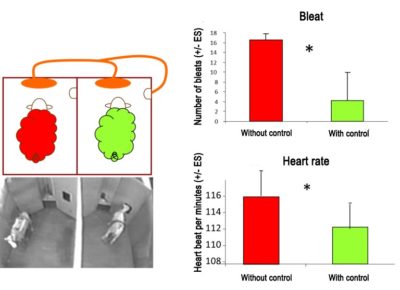
Figure 3. Influence of controllability on suddenness responses. The lambs are tested by pair: one can activate the food distribution (lamb with control), the other cannot (lamb without control). When the lamb with control activate the food distribution, both lambs received the same quantity of food. Whereas both animals receive the same quantity of food, emotional responses linked to the food distribution (agitation and tachycardia) are stronger in the lamb without control (Greiveldinger et al., 2009).
The ethological adaptation of the approach originally developed in human psychology offers a promising avenue for understanding the emotional experience of animals (Boissy et al., 2007a). Acknowledging the animal’s evaluation capacities, combined with an assessment of its behavioural and physiological reactions, allows us to explore the wealth of its emotional repertoire. Based on the evaluation combinations identified in humans and defined to generate specific emotions, it is possible to postulate that animals have the potential to feel various emotions such as fear, rage, despair, boredom, even disgust, but also joy and pleasure (Veissier et al., 2009). The results of this work, which has been carried out on other animal species (rats, pigs and birds), validate our conceptual framework inspired by cognitive psychology theories.
How the accumulation of emotions modifies an animal’s evaluation processes and welfare in a long-lasting manner
While emotions constitute the basic elements of welfare, their short-lived nature contrasts with the persistent states of welfare. To better understand how to go from a single emotion to a state of welfare, we can once again borrow from psychological approaches. A significant body of work in human psychology has shown how emotions can have a deep impact on cognitive processes, such as learning and memory performances. Such emotional modulations of cognitive processes also exist in animals (Paul et al., 2005). For example, heifers subjected to a strong stressor are unable to abandon a previously learned behaviour that is no longer rewarded (Lensink et al., 2006). In addition to affecting learning and memory performances, work in human psychology has clearly shown how emotions act as key factors in other cognitive functions, such as judgement and decision-making (Mendl et al., 2009).
New studies have been conducted on sheep to explore the way emotions can influence evaluation or judgement processes, the very ones which cause emotions as we saw in the previous section. We therefore asked ourselves if an emotional experience could change the way in which an animal perceives its environment. After learning to discriminate between a location where a bucket is associated with a punishment and a second location where the same bucket is associated with a food reward, lambs are then re-exposed to the bucket placed in between the two locations, as a deliberately ambiguous situation. If the lambs are placed in a livestock crush just before the go/no-go test, they demonstrate a judgement bias: they avoid the bucket placed in the middle area in the same way they avoid the bucket placed in the area associated with the punishment (Doyle et al., 2011a). However, this judgement bias is no longer observed if the test is conducted several hours after the restraint. A negative emotion, here induced by the restraint, is therefore capable of momentarily changing the animal’s cognitive processes, which themselves create emotions.
|
Figure 4. Percentage of approach to a bucket of food based on the location of the bucket. Lambs are trained to distinguish between the same bucket’s two locations: one in which the bucket is filled with food (go), the other in which it is empty and associated with a frightening event (no-go). Once the go/no-go instruction was learnt, half of the lambs were subjected to six weeks of a validated moderate stress treatment lasting six weeks. After this treatment, the lambs are given the go/no-go test once again but this time the bucket is placed between the two learnt areas to make it an ambiguous location for the animal. The stressed lambs avoid going near the bucket placed in the middle area, unlike the control animals. Therefore, prolonged exposure to anxiety-inducing events reduces the expectation of positive events and reinforces a negative interpretation of ambiguous events (Doyle & al., 2011b; Destrez & al., 2013). |
We then exposed lambs to a moderate stress model in which the animals are repeatedly and unpredictably exposed to stressful events (presence of a dog, transport, delayed food delivery, shearing, etc.) for six weeks. After this stress treatment, the lambs were given a go/no-go test. The stressed lambs avoided going near the bucket placed in the middle area, unlike the control animals (Doyle et al., 2011b; Destrez et al., 2013; Figure 4). Therefore, a stressful experience at a young age creates a lasting bias in the animal’s cognitive processes, as it tends to pay more attention to negative events. This lasting modification of the evaluation process could explain the persistence of a state of stress beyond the exposure to the stressful situation.
In farming, gestating females can be exposed to adverse practices and/or external disturbances (shearing, transport, handling, sanitary isolation, etc.) that when repeated can lead to various levels of stress that can alter the maturing foetus and later affect the offspring’s behavioural development and well-being (Braastad, 1998). Thus, lambs born to isolated ewes that were transported during their gestation show exacerbated exploratory behaviour (Roussel et al., 2008). Likewise, lambs of ewes that received negative handling during gestation show increased fearfulness (Coulon et al., 2011). We wanted to explore how stress experienced by a gestating female impacts its offspring’s evaluation and judgement processes. In the final third of their gestation period, ewes were exposed or not to the same moderate stress treatment defined in our previous work; their offspring were then given a judgement test at the ages of two and four months. The same judgement biases as those shown in lambs exposed to stress at a young age were observed: lambs born to mothers exposed to stress during their gestation avoided the bucket placed in the middle zone whether two or four months after birth (Coulon et al., 2015; Figure 5). The effects of prenatal stress are therefore more persistent than in the case where the stressful process is applied to the animal itself. Furthermore, the change in judgement is all the more marked as the mothers had been previously characterised as strongly reactive. The accentuation of the effects of prenatal treatment therefore seems to depend on the intensity of the stress experienced by the ewes during gestation, with active ewes perceiving the adverse events of the treatment more negatively, as confirmed by their higher cortisol levels, which may have affected the lambs’ development. If exposed to chronic stress or repeated disturbances, a portion of the maternal cortisol is thought to cross the placenta barrier and could affect the development of the foetus.
|
Figure 5. Female lambs’ latency of approach to a feed bucket depending on the location of the bucket, in lambs born to mothers exposed or not to a stressful experience during gestation. After being trained to distinguish between two placements of the same bucket associated with a reward or on the contrary a punishment (go/no-go), the lambs are then re-exposed to the bucket placed between these two opposite locations. Lambs born to mothers that were stressed during their gestation (prenatal stress) avoid going to the bucket placed more or less near to the reward location (Coulon et al., 2015). |
Inducing positive emotions to favour a state of well-being in animals
In light of game behaviour observed in young animals of many species and the aforementioned work on evaluation processes, we can no longer settle for a negative definition of welfare, namely reducing suffering and/or favouring adaptation to stress. As Dawkins (1980) and Duncan (1993) already noted, welfare does not only mean the absence of negative experiences or suffering, but also means seeking positive experiences. It is therefore vital that actions to improve animal welfare can stimulate the emergence of positive experiences. Based on the conceptual framework established to understand emotions in animals, it is therefore possible to identify cognitive processes involved in inducing positive emotions. This applies to i) anticipating positive events, ii) the option to control access to positive events, and iii) exposure to positive contrasts (i.e. the animal receives more positively valenced events than expected). Pigs that have benefited from cognitive enrichment using a sound signal during feeding thus appear less fearful (Zebunke et al., 2013). Returning to our experiment with lambs born to mothers that were stressed or not during gestation, we placed half the lambs in an environment enriched with objects (balls, brushes, etc.) and/or positively valenced events (sound and light systematically preceding food delivery, allowing for anticipation) for four weeks. In an ambiguous situation, the prenatally stressed lambs raised in enriched conditions present a less pessimistic view than conventionally reared, prenatally stressed lambs. Nevertheless, they still appear more pessimistic than lambs of mothers not exposed to stress during gestation. We should note that enriched farming conditions can partly counteract the detrimental effects of prenatal stress (Destrez et al., 2014; Boissy et al., 2016; Figure 6).
|
Figure 6. Female lambs’ latency of approach to a bucket of food depending on its location. Lambs are trained to distinguish between the same bucket’s two locations: one in which the bucket is filled with food (go), the other in which it is empty and associated with a frightening event (no-go). Once the go/no-go instruction has been learnt, two-thirds of the lambs are subjected to a moderate stress treatment for six weeks, paired or not with an enriched farming environment. After the treatment, the lambs are given the go/no-go test again but this time the bucket is placed more or less near to one of the two learnt locations, which are intended to be ambiguous for the animal (M+, M and M-). The stressed lambs had more trouble approaching the buckets placed in the middle areas, but the stressed lambs raised in an enriched environment more readily approached buckets in the ambiguous location nearest to the reward location. Therefore, being raised in an enriched environment can partly counteract the detrimental effects of a stressful experience (Destrez et al., 2014). |
There has still been little work done on this approach, which we need to examine further in order to try and improve animal welfare, in other words « do good » through revised or innovative practices. The experimental approach put forward in this paper should help consolidate the « cognitive enrichment » concept developed elsewhere (Boissy et al., 2007b). Eventually, if it can be clearly demonstrated that the repeated induction of positive experiences contributes to establishing an « underlying » positive mental state, or to preventing or even counteracting the development of negative mental states, such a behavioural approach could be proposed as part of an integrated animal health management process.
Conclusion
Animal welfare analysis, brought about by strong societal expectations, has required far-reaching changes in the way we study animal behaviour. It has led ethology to develop new conceptual frameworks inspired by cognitive sciences in order to scientifically understand animals’ emotional sentience. The work discussed in this paper refers to new conceptual frameworks borrowed from cognitive psychology. It shows that it is now possible to access the affective states of animals. The study of emotions-cognition relationships is an innovative approach that can be used to better interpret animals’ emotions and understand how animals can develop persistent affective states. An animal’s evaluation of its environment based on elementary cognitive processes is the origin of the emotions that it feels. The outcome of the evaluation, and therefore the emotion that the animal feels, is modulated by its own emotional experience. As the definition provided by ANSES (2018) reminds us, it is the way in which the animal perceives its environment, and not the environment per se, that determines its welfare.
The demonstration of the close relationship between emotional experiences and cognitive evaluation processes offers new perspectives for better understanding the nature of animals’ affective states. The focus will be on identifying acquired cognitive bias and/or cognitive predispositions likely to generate lasting affective disorders that can cause suffering and even lead to greater vulnerability to illness (Destrez et al., 2017). In any case, the recognition and acceptance of animal sentience should help put an end to the concept of « passive or reactive animal » in favour of that of a « sentient being », which acknowledges its capacity to feel emotions, evaluate its environment and act accordingly. It is only by using this concept that we will be able to change the way we are with animals by re(gaining) meaning in our relationship with them. Already it is possible to think of innovative farming practices in which animals play a genuinely active role. While the drafting of animal welfare regulations has led to a reduction in the constraints placed on animals, greater consideration of animals’ mental capacities when designing new farming systems should not only limit sources of stress and pain for animals but above all favour positive experiences for them and therefore improve their quality of life. To conclude, the recognition of sentience and mental states in animals largely relies on the acceptance of our empathy, backed by the experimental evidence provided by the study of the relationship between emotions and cognition, among others. Talking of mental states in animals does not necessarily mean that these states are strictly identical to those described in humans. Therefore, we must continue our scientific exploration of the relationship between emotions and cognition to accurately identify the very nature of the affective states in animals with which we are in contact and which we have the responsibility of respecting.
Acknowledgements
The author would like to thank his colleagues, particularly I. Veissier, V. Deiss and M.-M. Mialon (INRA) and C. Lee (CSIRO), and the many doctoral and post-doctoral students who carried out many of the experiments mentioned in the paper, namely L. Désiré, L. Greiveldinger, R. Doyle, A. Destrez, M. Coulon, B. Petit and R. Kyriazopoulou. Most of the work mentioned in the paper was backed by the AgriBEA network, INRA (scientific department Phase), and ANR (EmoFarm ANR- 09-BLAN-0339-01 project and PsySheep ANR-11-PDOC-01601 project).
References
* This approach consists in defining animal welfare in terms of what humans think animals want rather than letting animals speak for themselves.
ANSES (Agence nationale de sécurité sanitaire de l’alimentation, de l’environnement et du travail), 2018. Avis relatif au bien-être animal : contexte, définition et évaluation.
Boissy A., Arnould C., Chaillou E., Désiré L., Duvaux-Ponter C., Greiveldinger L., Leterrier C., Richard S., Roussel S., Saint-Dizier H., Meunier-Salaün M.C., Valance D., Veissier I., 2007a. Émotions and cognition: A new approach to animal welfare. Animal Welfare, 16, 37-43.
Boissy A., Manteuffel G., Jensen M.B., Moe R.O., Spruijt B., Keeling L.J., Winckler C., Forkman B., Dimitrov I., Langbein J., Bakken M., Veissier I., Aubert A., 2007b. Assessment of positive emotions in animals to improve their welfare. Physiology and Behavior, 92, 375-397.
Boissy A., Aubert A., Desire L., Greiveldinger L., Delval E., Veissier I., 2011. Cognitive sciences to relate ear postures to emotions in sheep. Animal Welfare, 20, 47-56.
Boissy A., Moe Oppermann R., Coulon M., 2016. Effects of prenatal stress and post-weaning enrichment on judgement bias in sheep. In: 50th Congress of International Society of Applied Ethology. Edinburgh (UK), 12-16 July.
Braastad B.O., 1998. Effects of prenatal stress on behaviour of offspring of laboratory and farmed mammals. Applied Animal Behaviour Science, 61, 159-180.
Calatayud F., 2010. Du comportement « fait de nature » au discours de l’éthologiste : réflexions sur la place de la subjectivité en éthologie. In : F. Burgat (Ed.), Penser le comportement animal. Editions de la Maison des Sciences de l’homme (Paris et Editions QUAE (Versailles), p 323-342.
Coulon M., Hild S., Schroeer A., Janczak A.M., Zanella A.J., 2011. Gentle vs. aversive handling of pregnant ewes: II. Physiology and behavior of the lambs. Physiology and Behavior, 103, 575–584.
Coulon M., Nowak R., Andanson S., Petit B., Lévy F., Boissy A., 2015. Effects of prenatal stress and emotional reactivity of the mother on emotional and cognitive abilities in lambs. Developmental Psychobiology, 57, 626–636.
Dantzer R., 1989. L’illusion psychosomatique. Editions Odile Jacob, Paris, 121 pp.
Dantzer R., 2002. Can farm animal welfare be understood without taking into account the issues of emotion and cognition? Journal of Animal Science, 80, E1-E9.
Dantzer R., 2010. Que faire du comportement dans les sciences du comportement ? In : F. Burgat (Ed.), Penser le comportement animal. Editions de la Maison des Sciences de l’homme (Paris et Editions QUAE (Versailles), p. 198-208.
Dawkins M.S., 1983. La Souffrance Animale. Editions du Point Vétérinaire, Maisons-Alfort, 152 pp.
Dawkins M.S., 2001. How can we recognise and assess good welfare? In: Broom, D. M. (ed.) Coping with challenge: Welfare in animals including humans. Dahlem University Press, Berlin, p 63-76.
Désiré L., Boissy A., Veissier I., 2002. Émotions in farm animals: a new approach to animal welfare in applied ethology. Behavioural Processes, 60, 165-180.
Désiré L., Veissier I., Després G., Boissy A., 2004. On the way to assess emotions in animals: Do lambs evaluate an event through its suddenness, novelty or unpredictability? Journal of Comparative Psychology, 118, 363-374.
Désiré L., Veissier I., Després G., Delval E., Toporenko G., Boissy A., 2006. Appraisal process in sheep: interactive effect of suddenness and unfamiliarity on cardiac and behavioural responses. Journal of Comparative Psychology, 120, 280-287.
Destrez A., Deiss V., Levy F., Calandreau L, Lee C., Chaillou E., Boissy A., 2013. Chronic stress induces pessimistic-like judgment and learning deficits in sheep. Applied Animal Behaviour Science, 148, 28–36.
Destrez A., Deiss V., Leterrier C., Calandreau L., Boissy A., 2014. Repeated exposure to positive events induces optimistic-like judgment and enhances fearfulness in chronically stressed sheep. Applied Animal Behaviour Science, 154, 30–38.
Destrez A., Boissy A., Guilloteau L., Andanson S., Souriau A, Laroucau K., Chaillou-Sagon E., Deiss V., 2017 Effects of a chronic stress treatment on vaccinal response in lambs. Animal, 11, 872-880.
Doyle, R.E., Fisher, A.D., Hinch, G.N., Boissy, A., Lee, C., 2009. Release from restraint generates a positive judgement bias in sheep. Applied Animal Behaviour Science, 122, 28-34.
Doyle et al., 2011aDoyle, R.E., Vidal, S., Hinch, G.N., Fisher, A.D., Boissy, A., Lee, C., 2010. The effect of repeated testing on judgement biases in sheep. Behavioural Processes, 83, 349-352.
Doyle et al., 2011bDoyle, R.E., Lee, C., Deiss, V., Fisher, A.D., Hinch, G.N., Boissy, A., 2011. Measuring judgement bias and emotional reactivity in sheep following long-term exposure to unpredictable and aversive events. Physiology and Behavior, 102, 503-510.
Duncan, I.J.H., 2005. Science-based assessment of animal welfare: farm animals. Revue Scientifique Et Technique-Office International Des Epizooties, 24, 483-492.
Duncan I.J.H., 1996. Animal welfare in terms of feelings. Acta Agric. Scand., 27, 29-35.
Fraser D., Duncan I.J.H., 1998. ‘Pleasures’,’Pains’ and Animal Welfare: Toward a Natural History of Affect. Animal Welfare, 7, 383-396.
Greiveldinger L., Veissier I., Boissy A., 2007. Emotional experience in sheep: Predictability of a sudden event lowers subsequent emotional responses. Physiology & Behavior, 92, 675-683.
Greiveldinger L., Veissier I., Boissy A., 2009. Behavioural and physiological responses of lambs to controllable vs. uncontrollable aversive events. Psychoneuroendocrinology, 34, 805-814.
Greiveldinger L., Veissier I., Boissy A., 2011. The ability of lambs to form expectations and the emotional consequences of a discrepancy from their expectations. Psychoneuroendocrinology, 36, 806-815.
Greiveldinger L., Boissy A., Aubert A., 2013. An ethological perspective of the relations between sociality and emotions in animals. In: A. Aubert (Ed.) Social Interaction Evolution Psychology and Benefits, Nova Science Publishers, New York, p 67-82.
Harding E.J., Paul E.S., Mendl M., 2004. Cognitive bias and affective state. Nature, 427, 312.
Lazarus R.S., 1991. Progress on a cognitive-motivational-relational theory of emotion. American Psychology, 46, 819–834.
Lensink B.J., Veissier I., Boissy A., 2006. Enhancement of performances in a learning task in suckler calves after weaning and relocation: Motivational versus cognitive control? À pilot study. Applied Animal Behaviour Sciences, 100, 171-181.
Mason J.W., 1971. A re-evaluation of the concept of « non-specificity » in stress theory. Journal of Psychiatry Research, 8, 323–333.
Mendl M., Paul, E.S., 2004. Consciousness, emotion and animal welfare: insights from cognitive science. Animal Welfare, 13, S17-S25.
Mendl M., Burman O.H.P., Parker R.M.A., Paul E.S., 2009. Cognitive bias as an indicator of animal emotion and welfare: Emerging evidence and underlying mechanisms. Applied Animal Behaviour Science, 118, 161-181.
Merleau-Ponty M., [1947] 1997. La Structure du Comportement. Le Seuil (Paris), 314 pp.
Paul E.S., Harding E.J., Mendl M., 2005. Measuring emotional processes in animals: the utility of a cognitive approach. Neuroscience and Biobehavioral Reviews, 29, 469-491.
Roussel-Huchette S., Hemsworth P.H., Boissy A., Duvaux-Ponter C., 2008. Repeated transport and isolation during pregnancy in ewes. II. Differential effects on emotional reactivity and weight of their offspring. Applied Animal Behaviour Science, 109, 275-291.
Sander D., Grandjean D., Scherer K.S., 2005 A systems approach to appraisal mechanisms in emotion. Neural Networks, 18, 317–352.
Scherer KR., 2001 Appraisal considered as a process of multi-level sequential checking. In: Scherer KR, Schorr A and Johnstone T (eds) Appraisal Processes in Emotion: Theory, Methods, Research. Oxford University Press, New York and Oxford, pp 92-120.
Veissier I., Boissy A., Désiré L., Greiveldinger L., 2009. Animals’ emotions: studies in sheep using appraisal theories. Animal Welfare, 18, 347-354.
Zebunke M., Puppe B., Langbein J., 2013. Effects of cognitive enrichment on behavioural and physiological reactions of pigs. Physiology and Behavior, 118, 70–7Soutenez 9.


